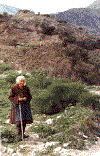
Click on any of the pictures to enlarge them
45 km north of Limassol through
Ayios Theodoros.
Agros is the centre of the district. A 19th
Century church now stands on the site of the monastery of Panagia Elousa, founded by monks
from Constantinople in the 9th Century. (See more)
LOUVARAS
28 km from Limassol on the south of the Troodos
range, off the Limassol - Agros road.
In the centre of the village is the small church of A yios Mamas built in 1455
with mural paintings signed by Philip Goul. (1495)
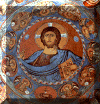
LAGOUDERA
Lagoudera village is 15 km from Agros or off the
Kakopetria - Troodos - Limassol road (Karvounas crossroad).
The 12th Century church of Panayia tou Arakou, situated just outside the
village has frescoes which are some of the finest of the late Comnenian style (c1192)
prevailing throughout Greece, the Balkans and Russia. Together the Asinou church and that
of Agios Nikolaos tis Stegis, it is considered to be one of the most important Byzantine
churches on the island. Visitors can ask for the key and be escorted by the priest who is
to be found in the premises next to the church.
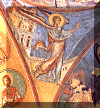
KOURDALI
7 km off the Kakopetria - Troodos road, after
Spilia village.
The village’s early 16th Century church with frescoes of the same period, is
dedicated to the Virgin Mary (Panagia).
PELENDRI
3 km below Kato Amiantos, off the Karvouna - Lemesos road, 32 km from Lemesos.
Once the property of Jean de Lusignan, son of the Lusignan King of Cyprus, Hugh
IV. There are two interesting churches; the 14th Century church of Timiou Stavrou, the
Holy Cross, with beautiful wall paintings and the church of Panagia Katholiki in the
centre of the village which dates to the early 16th Century with paintings in the
Italo-Byzantine style.
SOLEA VALLEY
On the main Lekosia - Troodos road 56 km from Lefkosia and 56 km from Lemesos
(via Kato Amiantos and Saittas).
The Solea valley is famous for its apples, its Byzantine churches and its
picturesque villages. Kakopetria and Galata villages, preserving much of their traditional
folk architectural character, are popular hill resorts. Other charming villages in the
valley are Evrychou, Flasou and Korakou.
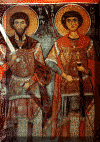
KAKOPETRIA
Agios Nikolaos tis Stegis
The church of Agios Nikolaos tis Stegis, ‘Saint Nicholas of the Roof’
stands about 5 km to the north of the village and once belonged to a monastery. It is
completely painted with murals dating from the 11th to the 17th Century and is considered
to be one of the most interesting Byzantine churches on the island. The church took its
name from the steep pitched wooden roof which was built to protect it from climatological
conditions. The small 16th Century church of Panagia Theotokos, off the main road, has
retained about half of its murals. The church of Agios Georgios Perachoritis, on the east
of the village, has some very original wall paintings belonging to the first quarter of
the 16th Century. The old quarter of the village has been declared a protected area and
traditional houses have been restored.
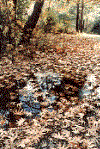
GALATA
Panagia Podithou
There are four painted churches in and around the village. The church of Agios
Sozomenos dates to the early 16th Century and retains a complete series of frescoes in the
post-Byzantine style. The church of Archangelos Micheal or Panagia Theotokos is a
timber-roofed chapel just below the village and is completely painted in the
post-Byzantine style of the early 16th Century. Nearby is the larger church of Panagia
Podithou which once belonged to a monastery. It was erected in 1502 and its paintings are
of the Italo-Byzantine style. The small church of Agia Paraskevi on the old Kakopetria -
Galata road has murals dating to 1514. The old inn which has been restored, the ‘Chani
Kalianon’, is an nice example of rural architecture.
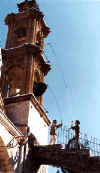
KYKKOS MONASTERY
20 km west of Pedoulas village.
The most famous and richest monastery in Cyprus. Founded in 1100 and dedicated
to the Virgin Mary. It has one of the three surviving icons ascribed to Saint Luke. The
icon, covered in silver gilt and enclosed in a shrine of tortoiseshell and
mother-of-pearl, stands at the front of the iconostasis. The Archbishop Makarios served
here as a novice. Concurrent with his wishes he is buried at Throni, 3 km west of the
monastery, and not far from his native village of Panagia. Religious fairs are held at the
monastery on 15th August and 8th September.
|
KRASOCHORIA
The area of Krasochoria, meaning 'wine villages',
is found on the south side of the Troodos range. Traditions are kept alive in these
villages where the cultivation of the vineyards and wine making are still the main
occupation of the inhabitants. This is the area which produces the famous local dry red
wine. The area is reached from the Limassol - Paphos road turning right after Erimi village.
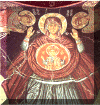
NIKITARI
Asinou Church, 5 km from Nikitari village, off
the main Nicosia - Troodos road, around 20 km north of Kakopetria.
An early 12th Century church dedicated to the Virgin Mary with frescoes of the
12th Century and later periods, considered to be amongst the finest examples of Byzantine
mural paintings on the island. Visitors should ask for the priest of Nikitari village to
escort them.
MARATHASA VALLEY
This fertile valley, well known for its cherries, yum, lies on the north side of
the Troodos range. It offers an alternative route to Troodos through the lovely mountain
villages of Kalopanagiotis, Moutoullas, Pedoulas and Prodromos. The road to Kykkos
Monastery is signposted and turns off the main Lefkosia - Troodos road just below
Evrychou. Marathasa is also reached for the Limassol - Platres - Prodromos road (around 65
km from Limassol).

KALOPANAGIOTIS
Agios Ioannis Lampadistis
The village is famous for its sulphur springs and the church of
Ayios Ioannis
Lampadistis, with excellent frescoes of the 13th and 15th century. Originally a monastery,
it is a complex of two churches and a chapel of various dates. One of the biggest
religious fairs in the valley is held here on St. John’s day, 4th October. In Cyprus
name days are more important than birthdays.
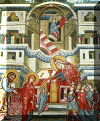
MOUTOULLAS
Panagia tou Moutoulla
Less than a kilometre further up is Moutoullas village with its tiny 13th
Century chapel of Panagia tou Moutoulla, one of the earliest dated examples of the
steep-pitched wooden roof type with frescoes dating to 1280. Visitors can obtain the key
from the adjacent house. The traditional craft of wooden carved basins has been preserved
in Moutoullas.

PEDOULAS
Archangelos Micheal
The third village up the mountain is Pedoulas, a summer resort famous for its
cherries. The painted church of Archangelos Michael in the lower part of the village dates
from 1474. Visitors can obtain the key from the adjacent house.
PITSYLIA
The Pitsylia area lies on the eastern slopes of the Troodos mountain range.
Picturesque villages cling to the mountainside amid vineyards, orchards of almond and
hazelnut trees and an astonishing array of wild flowers. The Pitsylia area can be reached
either from Lefkosia (Nicosia) or Lemesos (Limassol). From Nicosia one passes through
Palaichori - Agros, or through Kakopetria - Karvounas - Kyperounta. From Lemesos one takes
the Lemesos - Agios Theodoros - Agros road, or Lemesos - Kato Amiantos - Karvounas -
Kyperounta road.

PALAICHORI
45 km south of Lefkosia (Nicosia) of the
Lefkosia - Agros - Lemesos road, and 15 km from Agros.
The church of Metamorphosis tou Sotiros, the Transfiguration of the Saviour, is
an early 16th Century chapel on the hill, overlooking the old village.
Its interior is painted with one of the most accomplished series of murals of the
post-Byzantine period in Cyprus. The church of Panagia Chrysopantanassa built in the 16th
Century contains wall paintings. It is the main church of the upper village.

PLATANISTASA
Platanistasa village, 15 km from
Agros, 30 km off the Lefkosia - Astromeritis road, turning left before Peristerona
village.
A 15th century church, Church of the Holy Cross of Ayiasmati lies about 3 km
outside this charming old village, it retains the most complete cycles of mural paintings
of the second half of the 15th Century in Cyprus. Visitors can ask for the key from the
village priest.
OMODOS
A wine producing
village, once the property of Sir John De Brie, Prince of Galilee, with the Monastery of
Stavros, 'Holy Cross', standing by the stone paved square. Embroidery is a specialty of
this village especially quilts and tablecloths.

FOINI
4 km west of Pafos
Famous for its pottery and its loukoumi sweet. Visitors can see the
Pilavakeion private pottery collection and suck at the same time.
KOILANI
1,5 km southwest of Pera Pedi, off the Limassol - Troodos road.
Another attractive wine producing village, with
the single aisled vaulted church of Agia Mavri,typical of 12th Century architecture with
murals of the late 15th Century. The village also has its own local ecclesiastical museum.

|
![]()
![]()